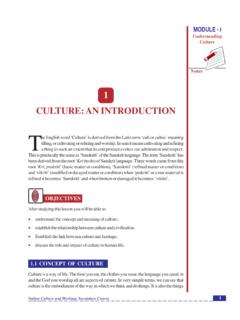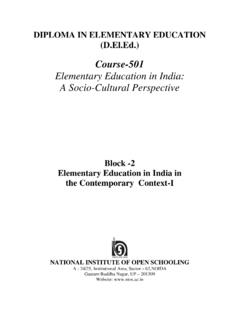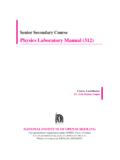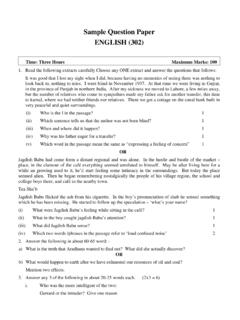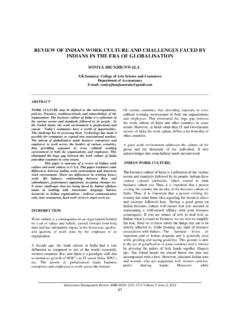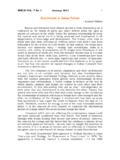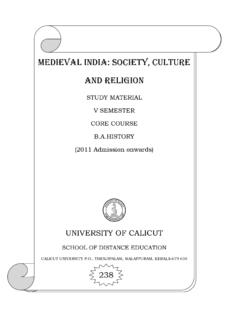Transcription of 2 INDIAN CULTURE H - National Institute of Open …
1 INDIAN CULTURE MODULE - I. Understanding CULTURE Notes 2. INDIAN CULTURE . H. ave you ever thought of the amazing progress we, as human beings, have made in various spheres of life, be it language, literature, art and architecture, science or religion? Have you ever wondered how all this has been possible? This happened because, we did not have to make a fresh beginning each time, but were able to make use of and build on the work of past generations. You have never had to bother about having to make your own script or creating a new language system for yourself. These are already given to you which you enjoy as a member of society. Then you build on it by making your contribution or addition which further becomes an asset for the coming generations. This is a continuous and never-ending process. It is a precious possession unique to human beings and is known as CULTURE .
2 CULTURE is a way of life. You, your family has a CULTURE and so does your region and your country. You may be curious to know about the uniqueness of INDIAN CULTURE and find out its distinct characteristics. In this unit we will understand how INDIAN CULTURE is unique and what are its characteristics. OBJECTIVES. After reading this lesson you will be able to: describe the distinctive features of INDIAN CULTURE ;. identify the central points and uniqueness of INDIAN CULTURE ;. discuss the importance of spirituality in INDIAN CULTURE ;. explain the points of diversity and underlying unity in it; and trace the process of infusion into and integration of elements from other cultures in INDIAN CULTURE . INDIAN CULTURE and Heritage Secondary Course 9. MODULE - I INDIAN CULTURE Understanding CULTURE CHARACTERISTICS OF INDIAN CULTURE . INDIAN CULTURE is as many sided as life.
3 It includes intellectual and social aspects of any human being. It also takes account of the aesthetic instinct as well as the spiritual impulses Notes of human being. It has also, in effect, an appeal to the subconscious as a force making for the formation of character. Look at the map of India and you see India is a vast country with a lot of diversity in her physical and social environment. We see people around us speaking different languages, having different religions and practising different rituals. You can also see these diversities in their food habits and dress patterns. Besides, look at the myriad forms of dance and music in our country. But within all these diversities there is an underlying unity which acts as a cementing force. The intermingling of people has been steadily taking place in India over centuries. A number of people of different racial stock, ethnic backgrounds and religious beliefs have settled down here.
4 Let us not forget that the composite and dynamic character of INDIAN CULTURE is a result of the rich contributions of all these diverse cultural groups over a long period of time. The distinctive features of INDIAN CULTURE and its uniqueness are the precious possession of all indians . Continuity and Change Many great cultures had developed in different countries and regions of the world. Many of them have perished or have been replaced by other cultures. However INDIAN CULTURE has had an enduring character. Despite major changes and upheavals significant threads of continuity can be traced throughout the course of INDIAN history right upto the present day. You may have read about the Harappan civilization which flourished in the INDIAN subcontinent over 4500 years ago. Archaeologists have found evidences to show that cultures existed here even before the matured phase of the Harappan civilization.
5 This tells us that we have a very long history behind us. And yet what is amazing is that even today the pattern of a house in an INDIAN village is not very different from that of a Harappan house. Some aspects of Harappan CULTURE are still practised, such as, the worshipping of Mother Goddess and Pashupati. Similarly, Vedic, Buddhist, Jain and many other traditions continue to be followed even today. At the same time one should not lose sight of the changes as are evident in the multistoried buildings in the metropolitan cities like Mumbai and Delhi, quite unlike the Harappan houses that had only one storey. The point to be noted here is that continuity and change in our civilization has gone hand in hand. In fact, a remarkable feature of INDIAN CULTURE is that along with continuity it has kept on changing, whereas the basic spirit of our CULTURE continued.
6 It has kept on discarding what was becoming irrelevant in the modern age. In our long history, there have been periods of ups and downs. As a result, movements have grown and reforms brought about. The reform movements in the Vedic religion brought about by Jainism and Buddhism in sixth century BC and the religious and social awakening in the eighteenth and nineteenth centuries in 10 INDIAN CULTURE and Heritage Secondary Course INDIAN CULTURE MODULE - I. Understanding CULTURE modern India are a few examples when revolutionary changes were brought about in INDIAN thought and practices. Yet the thread of basic philosophy of INDIAN CULTURE continued and still persists. Thus a process of continuity and change has always been a feature of INDIAN CULTURE . This shows the dynamic character of our CULTURE . Variety and Unity Notes INDIAN CULTURE , over the last three mellenia, has successfully, but quietly, observed the best assimilable parts from other religions and cultures, from time to time and integated them into itself.
7 Indeed few cultures in the world have such variety as the INDIAN CULTURE . You may perhaps wonder why the people of Kerala use coconut oil while the people of Uttar Pradesh use mustard oil for cooking. This is because Kerala is a coastal state and coconut grows here in plenty. While Uttar Pradesh is a plain area which is favourable for the growth of mustard. What is the similarity in the Bhangra dance of Punjab or the Pongal of Tamil Nadu or the Bihu dance of Assam? Both are celebrated after a rich harvest of crops. Have you noticed the different languages that we speak like Bengali, Tamil, Gujarati or Oriya? India is the home of many forms of dance and music which we normally use for festivals and social functions like marriages or the birth of a child. A large number of languages and dialects are spoken in our country which has led to the growth of a great variety of literature.
8 People belonging to eight great religions of the world co-exist here in a harmonious manner. Do you know that India is home to many religions of the world like Jainism, Buddhism, Sikhism and of course Hinduism. Numerous styles of architecture, sculpture and painting have developed here. Different styles of music and dance, both folk and classical, exist in the country. So also are numerous festivals and customs. This wide variety has led to the making of INDIAN CULTURE both composite one and rich and beautiful at the same time. Why is there so much variety in our CULTURE ? There are many reasons for this. The vastness of the country and variation in its physical and climatic features is an obvious reason for the variety. The second important reason for the variety in our CULTURE is the intermingling among various ethnic groups. Since time immemorial, people from far and near have been coming and settling here.
9 We find people belonging to different racial stocks like the Proto-Australoids, the Negroids and the Mongoloids living in India. Various ethnic groups like Iranians, Greeks, Kushanas, Shakas, Hunas, Arabs, Turks, Mughals and Europeans also came to India, settled here and intermixed with the local population. The people belonging to other cultures brought their cultural habits, thoughts and ideas, which got amalgamated into the existing CULTURE . You will be surprised to know that it was only around second century BC that stitched clothes such as salwars, kurtas, topees, etc. were brought to India, by the Kushanas, Shakas and Parthians. Prior to that indians wore clothes which were unstitched. The latest is the introduction of shirts, trousers, skirts, etc. which were brought by the Europeans in INDIAN CULTURE and Heritage Secondary Course 11. MODULE - I INDIAN CULTURE Understanding CULTURE the eighteenth century.
10 India through the ages has shown a remarkable capacity for assimilation of ideas. This has contributed to the variety and richness of our CULTURE . Along with contacts with outside cultures, cultural exchange between different regions of India has also continued. The Chikan work of Lucknow, Phulkari embrodery of Punjab, Notes Kantha embroidery of Bengal, Patola of Orissa show a distinct regional flavour. Although the centres in the South, North, East and West of India have their characteristic cultures, yet these did not develop in absolute isolation. Inspite of physical barriers, indians used to travel from one part of the country to another for trade or pilgrimage. Some regions were joined together through conquests or by alliance. As a result, people transmitted cultural habits and thoughts from one part of the country to the other. Military campaigns too took people from one place to another.
